

School History
 |
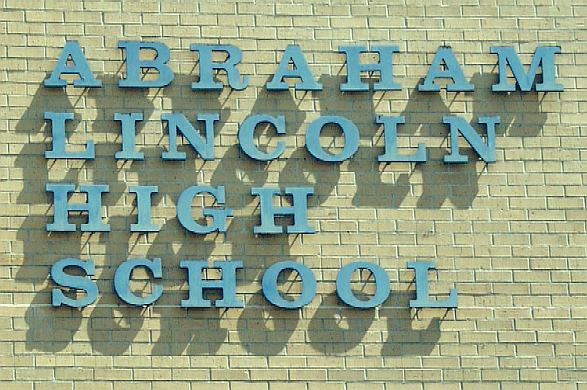 |
| Brief History | Early History | Burned History | Dedication of A.L. | Statue Status | Building Facts - New A.L. |
 More than 30,000
Mormon refugees flooded through Kanesville (Council Bluffs) in the mid
1800's on their way to the Great Salt Lake Valley. The Mormons built
more
than 80 communities in Southwest Iowa, organized churches, tuition
schools,
city and county governments, courts, band and choral concerts and four
newspapers. Their scores of business boomed when the California Gold
Rush
of 1849 started flooding through Kanesville. Kanesville was named for
Thomas
Kane, a man sympathetic to the plight of the Mormons. Kanesville was
renamed
Council Bluffs in 1853.
More than 30,000
Mormon refugees flooded through Kanesville (Council Bluffs) in the mid
1800's on their way to the Great Salt Lake Valley. The Mormons built
more
than 80 communities in Southwest Iowa, organized churches, tuition
schools,
city and county governments, courts, band and choral concerts and four
newspapers. Their scores of business boomed when the California Gold
Rush
of 1849 started flooding through Kanesville. Kanesville was named for
Thomas
Kane, a man sympathetic to the plight of the Mormons. Kanesville was
renamed
Council Bluffs in 1853.
Abraham Lincoln visited Council Bluffs in 1859. He met Grenville Dodge, a railroad engineer and later a Civil War general. Abraham Lincoln had the foresight to realize Council Bluffs should be the eastern terminus of the transcontinental railroad.
The first school board was elected March 14, 1859 with D.C. Bloomer as president (Bloomer School is named after him and not his wife, Amelia, as many people erroneously assume.) The first high school, with two teachers, was started in 1860 "in rented rooms".
The first actual public school building was erected in 1864 at 120 Pierce and was used as a residence in the 1950's.
The first high school building was constructed in 1869 on the six acre tract which is now Kirn Field. It was dedicated November 14, 1871, was three stories high, and was known as Council Bluffs High School. The first class graduated in 1871.
Demands for a more "accessible location and for more space" led to the building of Abraham Lincoln High School at Bluff St. and Fifth Avenue in 1900. The old CB High building was torn down in 1908.
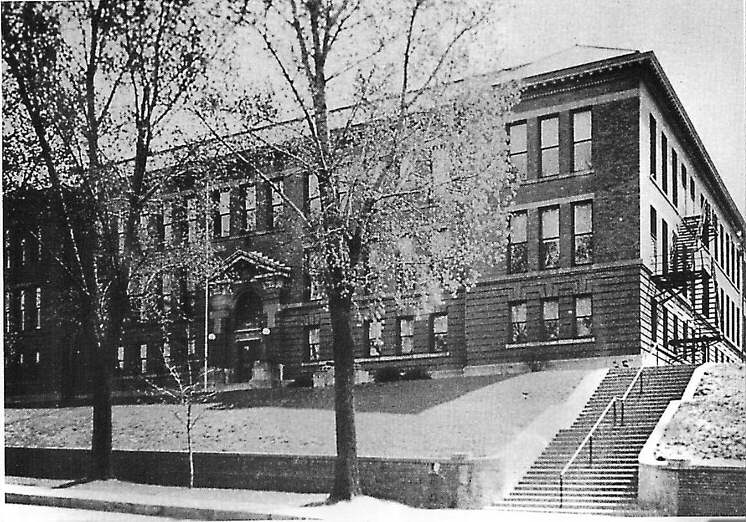
In 1961 a new junior high school was built on the eastern outskirts of Council Bluffs at 1205 Bonham Avenue and was called Eastside Junior High School. The plan was to build the new school in phases which would eventually be changed over to the new Abraham Lincoln High School. That change took place in the fall of 1967 when the Class of 1970 went from ninth grade (Jr. High) to tenth grade (High School). The old school building at Bluff St. and Fifth Avenue became Kirn Junior High School.
During the 1976-1977 school year, Kirn Junior High was destroyed by fire . The building was a total loss and Kirn students were bussed to Wilson Junior High, which ran two shifts until the new school was built.
In 1868 the first C.B.H.S. was begun on Pierce Street with one teacher. In 1869 the site was moved to Washington Avenue and not long after to the present site of Kirn Field. Then in 1901 the school was moved down the hill to Fifth Avenue and Bluff Street.
One of the earliest organizations, the Cadets, which was the only voluntary high school cadet company in the country had begun in 1892. Some early activities included drills, hiking, and a year-end compute where a sham battle was held.
Around 1913 competitive drills were held for a gold medal. In 1911 a signal corps was organized for Morse code and semaphore. For many years a cadet play was presented to make money. Further activities consisted of calisthenics, boxing and wrestling.
In 1918 the cadet program was made compulsory and became the first unit of the ROTC of the U.S. Army. This was a strong military town. The officers had their own club which held stunt nights and dances. They had a shooting gallery in the attic. There was inter company competition in all sports, rifle shooting, map reading, scouting, security, first aid and policies of the United States. The first Road Shows were presented by the ROTC.
In 1923 A.L. won first place in the National Junior ROTC shooting contest. Around this time there was a Drum and Bugle Corp. Military Balls began to be annual affairs. Only the experts of the girls' rifle team were eligible for honorary Colonel and Majors around the 1930's.
In 1924 a maneuver was held at Dodge Park with A.L. assaulting from Broadway and T.J. from the south. There were even two planes for scouting with photography and wireless communication.
Another early addition, the Echoes, was organized in 1901. By 1913 this was considered to be one of the best high school papers in the country. It included literary, news and athletic departments. Story contests were sometimes held for student entries. Papers were exchanged with schools across the entire nation.
In 1909 an orchestra was first organized with Mr. Henry G. Cox of Omaha as director. He was said to be one of America's most gifted musicians. After falling apart it was reorganized in 1915. Selections ranged from jazz to classics.
In 1920 new life came to the orchestra along with the band. The school board purchased new instruments and music for the new band, in which only three out of twenty members had previously played. They began by playing for football games and parades around 1919. Mr. Lockhart, the director, was mainly responsible for their growing excellence. It became recognized as the city band and played in Bayliss Park. Partially because of Mr. Kirn's influence, contests were held to create interest. A.L. always placed very well. For example, in the Civic Auditorium, A.L. beat Central, Lincoln and several other schools. The band went to Chicago Grand Park, won third place in a National Contest and played on the radio. They regularly went to state contests. In another Council Bluffs victory, only Joliet, Illinois placed ahead of them in a National Contest held in the Civic Auditorium. On another occasion when the band traveled to Colorado College, even though the audience was forbidden to applause, they gave A.L. a standing ovation. In 1942 the choir and orchestra broadcasted a national program for NBC for the National Music and American Youth Broadcast.
In 1905 the school had it's first good football team which beat Omaha for the first time in six years. Inter-class basketball was hindered by a low ceiling in the gym. Wrestling and gymnastics were begun and there was a large track team.
Some adults may pause when considering that in 1908 a "class scrap" ended with students paying for removal of paint on a roof and putting on a new flag pole rope. Some boys climbing the church tower and court house with pennants were intercepted by the police. Over the years many methods of initiation and class scrapping were devised. For instance, in 1913 Juniors and Seniors initiated Freshmen by clipping off curly hair of the boys or forcing them to play golf in the street with matches and hazelnuts. At other times forced to run the gauntlet or spoons from the lunchroom were placed in their pockets to be discovered by teachers. Fake tickets were frequently sold to the lunchroom and elevator.
The 1909 class bequeathed the statue of Abe. They first bought rings rather than pins, and the school on Kirn Field was finally destroyed that year.
In 1911 a Shakespearean Dramatic Club was organized. They presented plays and also analyzed them in a course of study.
Debate and speaking competition seemed to be vigorous within A.L.'s walls. The 1917 annual stated that CBHS literary representation was equal to many colleges. Triangular debates were held regularly with Fort Dodge and Sioux City. The feeling of competition ran very deep. Teams were chosen from all literary societies. The progress of the U.S. could be traced by the debate topics. For example, 1911, weather, the U.S. should adopt graduated income tax; 1913, recall of federal judges; 1924, restricting immigration and joining the World Court of the League of Nations.
Other debates held were among the literary societies. These were first organized in 1903. Delta Tau for girls and Philomathian for boys. In addition to debates, an Original Oratory and Original Declamatory Contest was held each spring. The Gerner Medals were presented to the winners. One was for oratory, one for dramatic, and for humorous.
The societies held private weekly programs in which underclassmen could participate as preparation for debating and oratory. Also spelling bees, parliamentary law drills, and extemporaneous speaking were practiced. Eventually the societies began to band together to give plays.
Around 1920 a great deal of emphasis began to be placed on the societies to diminish attention upon private sororities and fraternities, which were forbidden to those who desired to represent the school. Anyone could join these rivalry of literacy societies. Others added were, for boys - Aristotelian, Lonian, and Logotechneans; for girls - Cliosophian, Alpha, Thalian, and Erodelphian. The latter had actually decorated room 210 as the girl's literary room. With these additions, elimination for the contests became very complicated.
Along this same line, a public speaking class was begun around 1916. The Owlets practiced parliamentary drill, speaking and gave programs. Also members of societies were drawn or chosen by elimination to participate for state extemporaneous honors.
The earliest basketball competition was among classes. There was also a cadet team and the faculty was played. The first representative team was formed in 1909. Boys played at the new YMCA gym, freeing the old in the old cafeteria site so the girls could play. Teams were played at the Y, ranging among Omaha, Red Oak, Fort Dodge, and Plattsmouth. The 1915 team was third in the State. 1918 was runner-up (under Dutch White)), 1921 and 1923 were runners-up again.
The early football teams were composed of members of every class. They were state champs in 1907. The teams were not very good after that until about 1917 under Dutch White when they played excellent seasons of ball.
Track was begun in 1912. Events were mainly some cross country with Omaha and sprinting.
Tennis was begun in 1913 and was considered an excellent opening for girls. In 1924 Ernest Stowe brought glory to A.L. by winning the state championship.
Female athletics were mainly started around 1924. Hockey, basketball, captain ball, and volleyball filled the retinue. There was a fine girls' rifle team which competed about the country and against A.L. boys.
As of 1918 CBHS graduates were being admitted to all universities. Curriculum then contained some things omitted now - Etymology, Physiology, Greek, Physiography, Pedagogy, and ancient history.
A.L. gave hearty support to the national effort in World Wars I and II. Some students and many alumni served. Parties were Hooverized and girls worked in Red Cross rooms. War gardens and purchase of bonds by societies were other efforts. Aristotelian actually adopted a French orphan girl. After the Second War, a Veterans Club was organized to re-orientate the returning students.
It was with the arrival of Gerald Kirn, Principal, in 1919 that Abraham Lincoln became especially educationally oriented. Many new students' clubs sprang up. El Circulo Espanol made members familiar with language and customs through Spanish songs, games, and plays. At one time they had their own orchestra.
Latin Club was in addition to the CBHS boosters. They studied Roman life and history and held a Latin banquet wearing togas and pallas. They even had a mock French wedding in 1924.
A similar club was organized for German students.
A Cartoon Club created drawings for the Echoes and posters. In the TNT (Teacher's Normal Training) talks were given by teachers. A Bi-Phy-Chem Club studied for the business world. A branch of the Correspondence Club wrote letters around the world. Girl Reserves participated in many activities. A girls' Athletic Association sponsored tournaments, hiking, etc.
During this period the dark halls of the building were decorated by many famous works of art, a number coming directly from Europe. Under an agreement with the WPA, many statue copies appeared when A.L. was paid to repair statuary if a copy could be made by the school.
The Carnegie Corporation presented A.L. with the first high school collection of art books and modern pictures to be presented in the country. Because of superior music work they also presented A.L. a collection of records complete with player.
Many assemblies of high cultural content were held.
Vocational education was not neglected. Our students were barred and asked to demonstrate in a drafting contest at Ames because of their excellence.
Singing continually rang through the school from the first beginning of Glee Clubs in 1903. Operettas such as "H.M.S. Pinafore" and "The Mikado" were annually presented. The girls' and boys' Glees were separate for many years. Sometimes cantatas were performed and a male quartet periodically appeared. The clubs appeared throughout the area.
Numerous dramatic presentations were performed on the A.L. stage or at the Nicholas or Broadway theaters. Sometimes a morality play was performed, but often a light comedy or drama appeared. Productions were put on by classes or societies. Eventually Dramatics and Thespian Clubs were organized for those with great interest.
All the frantic activity has culminated in the 1960's as the old building prepared to graduate its final class. Yet the complex high school society will surely thrive in its fresh environment.
The class of 1967 was the last to graduate from A.L.H.S.
In the same year the name was stripped from the building and given to a new building that will have to start all over and build it's own memories. May it last as long and be as great. May the students who now bear the name be as proud as those before them. And to always remember they are a Council Bluffs school.
The old high school was rightly renamed "GERALD W. KIRN JUNIOR HIGH SCHOOL", after the same man that the football field on top of the hill on Fifth Avenue was named. The same man that gave us a long talk in the auditorium on our first day at A.L. which included a lot of do's and don'ts. The same man that stood at the entrance of the gym with his thumbs hooked in his vest pockets making sure we knew we were all being watched. Yes, the same man that was like a second father to so many of us. And to those who had no father he was a good substitute.
On the night the fire trucks came and the men strung their hoses and sprayed the water, it did little good, for the building was old and dry and could have been saved. The anguish was felt by all but was best said by the lady who was watching with tears in her eyes saying "OH! Please put out the fire." But the fire got hotter and hotter till the windows broke letting the heat and smoke out into the morning air disappearing into the black sky. One could get the scent of paint that made the walls so bright, varnish and wax from the floor we walked on.
The
next day, when it was light, one could see the remainder of the
building
standing there naked and without any form of it's old glory. One might
say, "Was I really in love with that old building?" But, no, it wasn't
the building at all but the memories. And those memories will last till
the last student of the class of 1967 passes away. May many of them
live
to be very old.
"It was an evening that started with some friends, we had been doing a little partying, smoking a little pot. We finished our evening at Zeplan's Palace, now Duncan's Cafe, a game room on Main Street. Ran out of money and then decided to go up to school for some stereo equipment or anything we could make some money off of. We searched and finally found an open window and entered the school. The music room was locked, the office was locked, so we started riffling through the school trying to find anything of value. Didn't want to turn on the lights of course, we would have been noticed by neighbors in the area. So a friend of mine was using matches to look inside of the desk drawers. I didn't pay any attention to what was happening to the matches after he was done with them. We wandered around through school and made our way to the third floor, Mrs. Cambell's art room. I was getting a little nervous at that time. Really scared. I wanted to get out and I spent most of my time at the window to make sure the police weren't on the scene. Turned around from the window to notice that there was a rather large fire in the middle desk drawer of the teacher's desk in this art room. At that point I ran over and kinda shoved my friend out of the way who was standing there and slammed the door shut thinking that would put the fire out and obviously it didn't and at that point left the school rather hastily. Went ahead and proceeded up to the field and were passing through there and ran into some friends from school, some football players who were having a beer party, and got to talking to them and at that point someone at the party noticed the school was on fire so we all climbed to the top of the bleachers to look down on the school. I was standing there kinda in awe at what we had done" (Browning Interview)
"I could hear the sirens. It sounded like they were coming from everywhere. I looked out my bedroom window and saw a glow over the bluff but I didn't know what happened until I read the paper the next morning." (Brown Interview)
"Fire
Leaves Kirn Students Homeless" (The Daily Nonpareil)
October
3, 1976. It was one little match and three rowdy kids that brought an
end
to the Kirn Jr. High School building previously the high school. Those
who didn't get the chance to walk the halls of this school missed out
on
the traditions and memories it stood for, being a museum of history for
Abraham Lincoln High School.
In
1900, the school was built in the shadow of a huge bluff named
"Gibraltar".
This hill became the school's guardian and watched over the school as
it
became home to the fighting hilltoppers of Council Bluffs High School
(Yearbook,
set #2). The community was so very proud of their new school that they
engraved a corner stone and made it a time capsule on December 13,
1900..
| "This cornerstone of Council Bluffs High School. Into
the
hollow stone
were placed the momentos of a by gone day. And into it were placed, too, the dreams of Council Bluffs citizens who wanted a better school and schooling for their children. Upon this same stone were built classrooms and labs, the auditorium and library, and these activity centers have themselves become cornerstones - the corner stones of character, discriminatory thoughts, social participation, and responsible citizenship are built upon them (Yearbook, set #2). |
Seventy Six years later when the time capsule was opened, they found a copy of the Nonpareil, Omaha Bee, and World-Herald newspapers; a class list of students that attended the school, the present courses of study, list of the teachers, list of school board members, a 1900 yearbook, and a coin from 1798. (Winchester Interview)
As the population of the community grew, the school became over crowded and the need for another new building arose. Instead of the original idea of one big Central High School, proposed for the site now occupied by Wilson Jr. High, they built a separate school in 1921 and named it Thomas Jefferson located on the west end of town. Then Council Bluffs High School became Abraham Lincoln and a beautiful white statue of Abe greeted his students at the entrance. It wasn't until 1926 when a track, football field, and a gym were added and the mascot became the lynx. Finally the school seemed complete.
But from the outside, the building looked like a square with four walls and a ceiling, but that was far from the truth. Many things came together to give the building a uniqueness not found anymore. A civil war cannon, donated by the class of 1911, guarded the front door with a carved pediment that read "high school" and had "1900" carved above that. In the center of the school was an auditorium and the hallways were in a circle around it. Each hallway was a one way street and the stair cases on each end were up only and a down only giving it a carousel look as the kids walked in circles.
Under the direction of Mr. Gerald Kirn, principal of AL, a program started that made students more aware of the fine arts. He had reproductions of famous paintings and beautiful sculptures and statues made to line the walls of the building. Paintings such as "The Signing of the Declaration of Independence," "The Landing of the Mayflower,""The Pilgrims Going to Church,""The Santa Fe Trail," and many other paintings of Indians. On the huge stairwell walls were murals of "The signing of the Magna Carta,""The appeal to Caesar," and the largest of them all in the front hallway was "The Lewis and Clark Expedition." Also, certain halls were dedicated to pictures that related to the rooms around them. In the Science wing, for example, there were portraits of great scientists and in the math wing were beautiful cathedrals. Not only were there famous paintings but famous artists' works. Such as: Raphael, da Vinci, Corrot, Monet, Manet, Renoir, Van Gogh, and Rockwell Kent. Most of those famous artists were gifts from the Carnegie Corporation and a lot of the other ones were donated by classes or the community. No matter where they came from they made a home lining the halls giving a huge amount of respect to the school by students and teachers. It was as close to a museum as a school could have ever become and the students seemed to enjoy it. "I remember those pictures that hung from a string in the hallway outside my room. Between class periods the kids would get those pictures swaying in unison. They never did hurt them but I always wondered how they did it" (Schiebler Interview). When the school was remodeled in the 60's many of the pictures were put in the basement and never returned to the places they belonged and in the basement they stayed.
The kids also found ways to have fun with the building besides it being a museum. "I'll never forget locker number 27! You ask some of the teachers and they can tell you about it" (Feilen Interview). It was 1965 and some industrial arts kids found this big blank space behind the lockers in between two sets of staircases. They put a false door in the back of one locker and they skipped class in there. "They got caught when Mrs. Ashman saw two kids in the hall and when she turned around they disappeared. She was very disturbed and had someone check the lockers. Behind number 27, there they were just hanging out!" (Schiebler Interview)
Even though students enjoyed it, this old building wasn't made to last forever. Everything on the inside was made out of wood and the wear and tear of everyday high school life was showing. Due to the circumstances, the school board decided to move the high school to East Side Junior High, remodel the old building, and make it Kirn Junior High.
After the move, something about the school and the name Abraham Lincoln seemed to change. "I think we left our traditions in the old building. There was just something about that place. It was an atmosphere" (Schiebler Interview). "It was a much more comfortable place. In the new building, it is too... I don't know" (Gepner Interview).
There was just something about the old building that only someone who spent the time to listen in pure quietness could get the real feeling. "It was an awareness that it was Abe's school. It was a personal feeling or presence of warmth or era. It had a special glow and you didn't know why but it was something special that you don't see here now" (Schiebler Interview). Maybe it was something with the school's "spirit".
|
O'er the school that bears his name through the long nights' adventures, during the busy days' activities, and the bustle that make a living soul of the building, a living soul that finds its strength in the hopes and ideals of his soul. The spirit of Lincoln abideth in the school where we work and play. The spirit of Lincoln abideth and we answer its challenge each day. (Yearbooks, set #2) |
Today, at Abraham Lincoln High School that spirit means something totally new. "When I hear the name Abraham Lincoln I think of our school and what we have accomplished here not the person or the president that he was" (Roth Interview). The presence of Abe was lost in the move when his old "house" became Kirn's.
Even though the building was remodeled by putting in new lockers, new floors, and new staircases (Winchester pictures). The school board didn't seem satisfied with that. In fact, they tried and tried to get a bond issue to pass that would entitle them to a huge brand new school. But it failed and it failed and it failed. Frustrated and upset, they began to try to prove that the school was horrid and a terrible mess. That is when they decided to not maintain the building thinking it would eventually fall apart (Winchester Interview).
However, two young boys, Mike O"Bradovich and Mike Winchester, were elected to the school board at ages 19 and 18 and they fought back trying to tell the public what was going on. They caught phony fire reports and unneeded engineering reports in an attempt to save the building. They drew up their own plans on how to make a "new" school inside of the old one (Winchester documents).
As time with no maintenance passed, what the superintendent hoped for happened: the ceiling began to leak and started to fall apart over one area of the school (Winchester pictures). "In the library, there were pillars about every three feet to hold up the ceiling. It looked like a forest" (Baker Interview). That is when "60 Minutes" came to Council Bluffs not only to do a story on the school but that the youngest public officials in the country were on the school board trying to override the superintendent and his plans to leave Kirn (60 Minutes video).
Finally, the school board elections came around in 1976. Two more people on the boys' side were elected. This was it. The big chance. Now Kirn would be saved. Or so they thought... The first newly elected school board meeting was scheduled for October 5, 1976. However, two days prior Mike Browning and Jerry Shoemake took care of the building in a hurry by forcing the school board to build a new one. "Except the fire didn't damage the whole school. Only the attic and the parts of the third floor. Granted, the water used to put it out hurt some, but what it really effected were those paintings in the basement, that was about it. However, somehow the first and second floors were damaged and things of value were written off as losses and stolen from the building before they let teachers and school board members into it" (Winchester Interview). Some people believe that someone wanted that building destroyed not just damaged and they say someone paid the three boys to burn it down. Unfortunately, we can never trace what happened if any wrong doing was done. But Browning denied it and said what he did was an accident. But was there another party involved? That is the question because there is a gray area where coincidence becomes wrong doing.
Anyway, the destroying-the-old-building method didn't make a new school very fast. In fact, it took three years. Where did Kirn students and teachers go in the meantime? They split shift with Wilson Jr. High. "I remember waking up at 4:30 in the morning getting ready for school. My body was so accustomed to that schedule that even on Sunday morning I was up at the crack of dawn. Also, a lot of teachers had problems (Brown Interview). It wasn;t easy for students either, Wilson students attended school from 6:40 to 11:40 and Kirn students attended Wilson from 12:15 to 5:15. They also had to share the lockers and they had to share books because the fire destroyed them and the money was being used to build a new Kirn. It was a difficult time for everyone.
Finally, the new school on Highway Six was done and Kirn students stepped foot into their new school. It was big, with a swimming pool and two gyms. However, Mr. Kirn's first school is still living on other places around Council Bluffs. At AL the statue greets people at the entrance and the stain glass windows that hung above the auditorium door are being stored next to the wrestling room. Back on Bluff street, the old Kirn gym and the football field are still remaining. Inside of the new Kirn building the carved entrance is pieced together in the library of the school and the corner stone is built into the wall near the main entrance. However, "The cornerstone is now old yet Abraham Lincoln/Kirn can never be old. For in an amcient or new building it is dedicated to an ageless service - that of educating young men and women" (Yearbook, set #2).
Today,
AL and Kirn share in the history of the old building and hopefully some
day the old traditions will come back to Abraham Lincoln High School.
Maybe
as the building gets older it will house the real spirit of good old
"Honest
Abe." Only time will tell.
| writers
note: Through
the researching of this topic I have grown very jealous to the students
who attended Abraham Lincoln High School/Museum. Looking at the slides and pictures and the 60 Minutes video I was taken back. That was my goal in this project: to feel like it was my school and I was a part of it. I want to say thanks to the teachers and especially Mike Browning and Mike Winchester who gave me an opportunity to go back and visit. Forever, I think I will be totally mad at the party who wanted such a land mark in history destroyed and if anyone can give me one reason why they didn't like it I can, now with my research, come back with one hundred reasons it was so great. I think the city of Council Bluffs deserved to have that building still standing. If not a school then a museum because knowing where it all began makes living it mean so much more. Now as I graduate from Abraham Lincoln High School I will take the memories I lived and the memories thousands of students lived through in the 96 years it has been around. They will never be forgotten. |
BIBLIOGRAPHY
ABRAHAM
LINCOLN HIGH
SCHOOL
CRIMSON AND BLUE
COUNCIL
BLUFFS: YEARBOOK
STAFF, 1921 - 1967
ABRAHAM
LINCOLN HIGH
SCHOOL
CRIMSON AND BLUE
COUNCIL
BLUFFS: YEARBOOK
STAFF, 1968 - 1995
BROWN, LARRY. INTERVIEW, FEBRUARY, 1996
BROWN, RUTH. INTERVIEW, MAY, 1996
BROWNING, MIKE. INTERVIEW, MARCH, 1996
COUNCIL
BLUFFS HIGH
SCHOOL
CRIMSON AND BLUE
COUNCIL
BLUFFS: YEARBOOK
STAFF, 1900 - 1927
FEILEN, ROGER. INTERVIEW, OCTOBER, 1996
"FIRE
LEAVES KIRN KIDS
HOMELESS",
THE
DAILY NONPAREIL
OCTOBER
4, 1976
GEPNER, MARY. INTERVIEW, MAY 1996
ROTH, MIKE. INTERVIEW, MAY 1996
SCHIEBLER, DON. INTERVIEW, APRIL, 1996
WINCHESTER, MIKE. INTERVIEW, MAY, 1996
"A
Time for Pride in
Council
Bluffs" is the prevailing spirit as Abraham Lincoln High School is
formally
dedicated this Sunday and open houses are held at three other school.
The
new facility at Bennett and Bonham avenues will be dedicated at a 2
p.m.
ceremony today in the Council Bluffs Field House there.
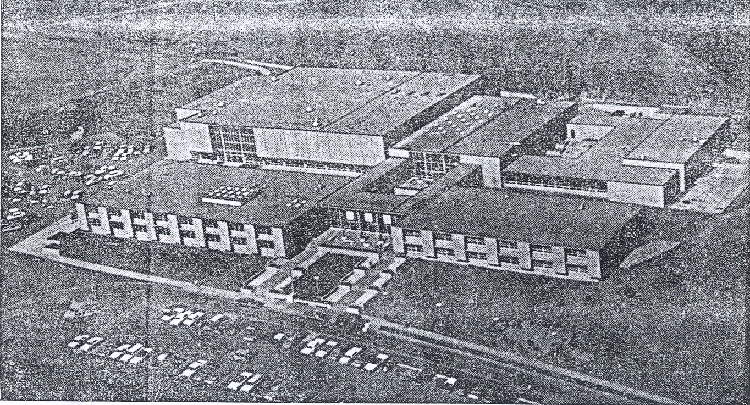 |
| New
Abraham Lincoln High School...at Bennett and Bonham Avenues. This
facility
was constructed in three phases
and cost more than $2.5 million. It was opened in 1960 as Eastside Junior High School and was taken over by A.L. in the fall of 1967. Classrooms are in the front of the building. The structure at the rear houses the Council Bluffs Field House, an auditorium and vocational wing. The field house and auditorium are for citywide use. |
Dr. Kirk Naylor,president of the University of Omaha, will deliver the dedicatory speech: "Focus on the Future."
Schools Supt. Robert Benton said Saturday the A.L. dedication, and open house activities at Thomas Jefferson High, Kirn Junior High and Walnut Grove Elementary schools are the culmination of several years of planning and hard work on the part of many school staff people, present and past members of the Board of Education and many citizens of the community.
18 Years Of Progress
"Tremendous
progress has
been made in recent decades to provide adequate physical facilities to
house the education programs of the Council Bluffs Community School
District,"
Dr. Benton said. "A long drought ensued following the completion of the
original Longfellow School in 1939. Not until 1950 were any additional
schools built. Hoover was completed that year, and a continuous
building
program has been in progress since that time. "Nearly $10.7 million has
been invested in school buildings in the past 18 years." (Story and
pictures
on page 6B.)
Additions to the T.J. and Walnut Grove buildings and the renovation of Kirn (formerly A.L.) will be on display from 3 to 5 p.m.
 |
|
|
Mr. Warren Swigart operated Chieftan Van and Storage in Omaha, Nebraska. Someone had left a statue of Abraham Lincoln there in storage and it was never claimed. Eventually, when he retired he had the statue moved to his residence thinking he would clean it up and then display it, but before he got this accomplished that statue was knocked over and was decapitated. His wife, Rita, having moved to a retirement home has graciously donated the statue of Abraham Lincoln to us. This statue was from the same mold as was ours at Abraham Lincoln High School. Mrs. Swigart believes there is one more statue somewhere in Omaha. We are going to have this statue refurbished and also placed in the halls of Abraham Lincoln High School.
Abraham
Lincoln High
School
Council
Bluffs, Iowa
Opened
as a High School
- September, 1967
The new Abraham Lincoln High School was built in three phases. The first phase, the southeast wing and present cafeteria, was built in 1960, and was used as Eastside Junior High School. The second phase, the southwest wing and the present girls' gymnasium, was built in 1964. This phase was also used as Eastside Junior High School.
Contracts for the third and final phase were let in January of 1966. This phase included the field house, music suites, auditorium, and the vocational wing to the northeast. With the completion of phase three during the summer of 1967, the building became Abraham Lincoln Senior High School and was opened for 10th, 11th, and 12th grade classes at that time.
The following statistics are presented for your information:
Classroom
Statistics
Administrative
Suite - Three private offices and one general office.
Health
Suite - Two "sick" rooms, one bathroom, and one waiting room.
Guidance
Suite - Six counseling offices and one "browsing" and general office.
Science
Suite - Three biology, two chemistry, and two physics laboratories, one
lecture and demonstration hall.
Home
Economics Suite - Eight unit kitchen area, one sewing room, and one
general
classroom area.
Library
Suite - General reading room, audio visual room, one divisible and two
regular seminar rooms, and materials storage and
preparation area.
General
Classrooms - Eight English, 3 1/2 mathematics, 6 1/2 commercial, one
art,
six social studies, and five general
classrooms.
Music
Suites - Vocal Music: One rehearsal hall, one office, one library, two
ensemble rooms, and four small group practice
rooms.
Instrumental Music: One rehearsal hall, one office, one library, one
ensemble
room, two small group practice
rooms, two band uniform storage rooms, instrument repair and storage
room.
Vocational
and Industrial Arts Wing - Two drafting rooms, one distributive
education
room, one electronics shop, one machine
and metal shop, one metal shop.
Miscellaneous
Facilities - One girls' gymnasium and all purpose room, one cafeteria,
one teachers' workroom and dining room,
one auditorium (seating capacity - 550), one field house (seating
capacity
- approximately 6,000), one
drama shop, one each boys' and girls' locker rooms, three sets of
restrooms,
and numerous custodian
storage areas.
Construction Cost Statistics:
PHASE I, 1960
| General Contract |
$354,750.00
|
||
| Electrical Contract |
34,936.00
|
||
| Mechanical Contract |
101,481.00
|
$491,167.00 |

Square
Feet of Area -
37,500
Square Feet
Construction
Cost per
Square
Foot - $13.10
PHASE II, 1964
| General Contract | $751,971.00 | 751,971.00 |
Square
Feet of Area -
55,000
Square Feet
Construction
Cost per
Square
Foot - $13.67
PHASE III, 1966
| General Contract | $790,877.00 | |
| Electrical Contract |
99,393.00
|
|
| Mechanical Contract |
212,712.00
|
1,102,982.00
|
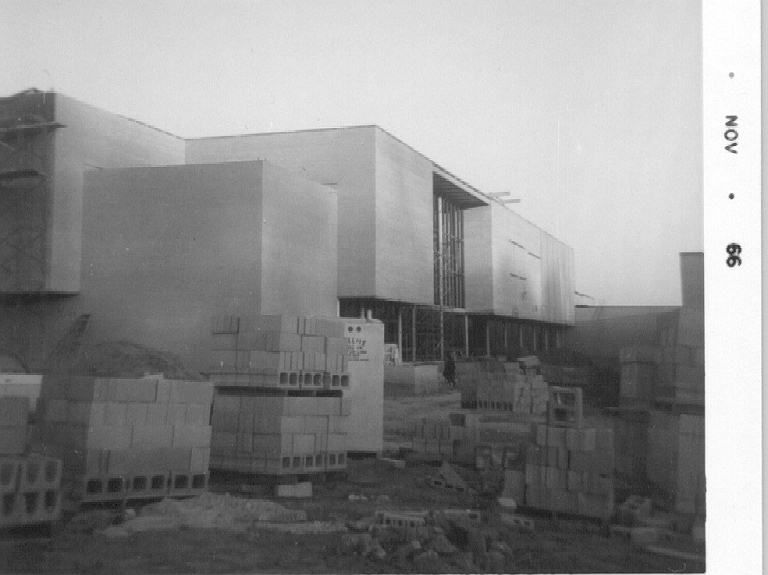
Square
Feet of Area -
75,000
Square Feet
Construction
Cost per
Square
Foot - $14.71
TOTAL CONSTRUCTION COST PER SQUARE FOOT - $14.00
Miscellaneous
Costs:
Site
Preparation,
1960
$72,800.00
Parking
Lot,
1966
$72,840.00
Bleachers,
Field House,
Auditorium Seating and Stage
Equipment, Lockers and Miscellaneous
Field
House Equipment, Court Develop-
ment, and Front Entrance Expansion,
1967
$167,465.00
313,105.00
$2,659,225.00
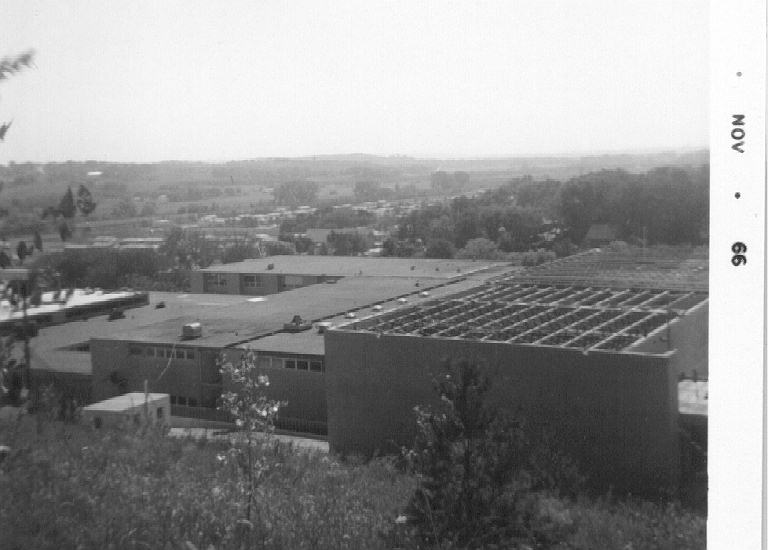
Recapitulation:
Construction
Contracts and Miscellaneous
Costs
$2,659,225.00
Less - Site Preparation and Parking
Lot
145,640.00
$2,513,585.00
Total
Square Feet -
167,500
Square Feet
Cost
per Square Foot -
$15.01
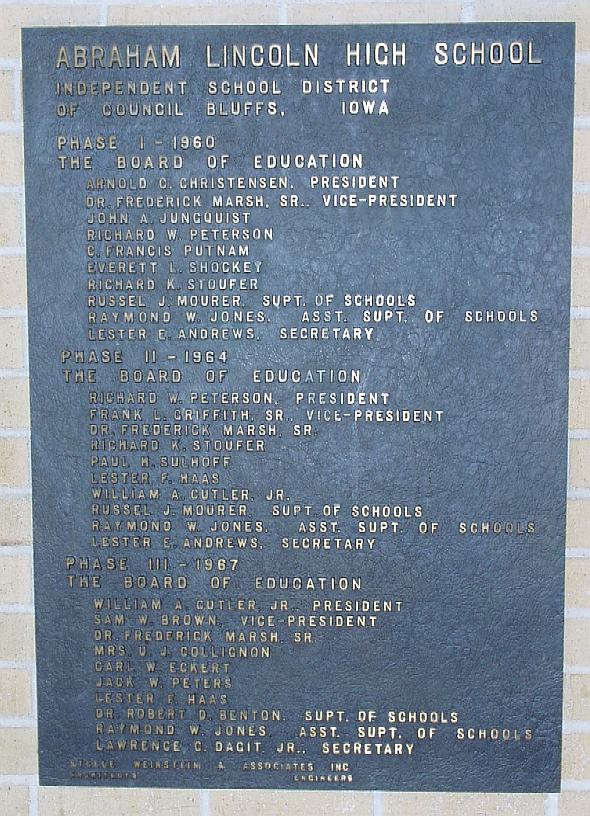
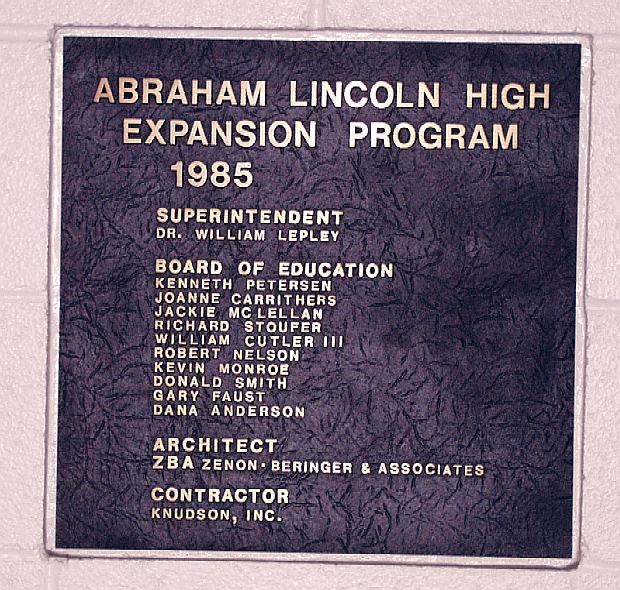
[Webmaster note: I would like to thank Dick Warner and Gary Emenitove for their input to this history. Many thanks to Melanie Shellberg (Principal ALHS) who also submitted material from various archives.